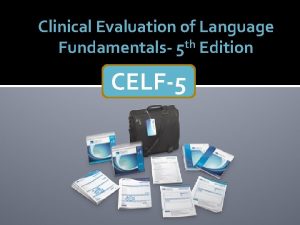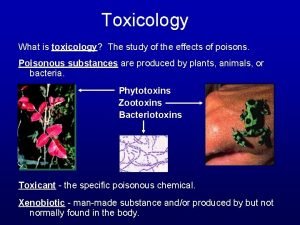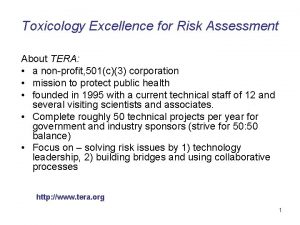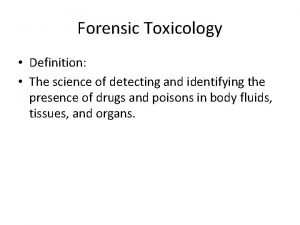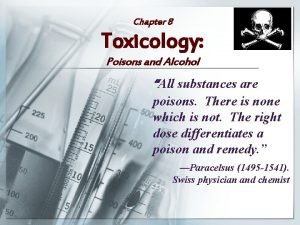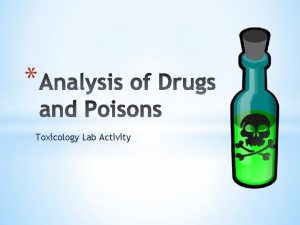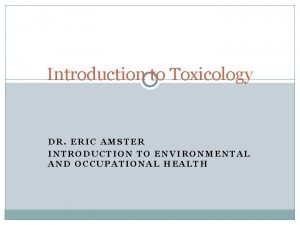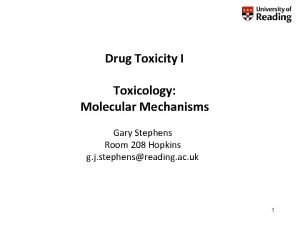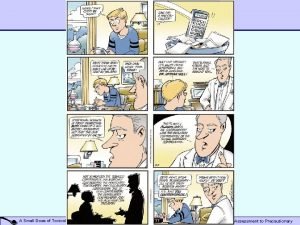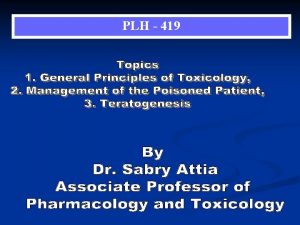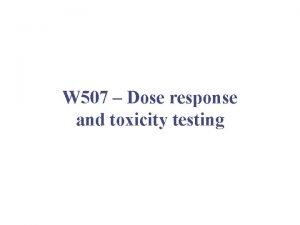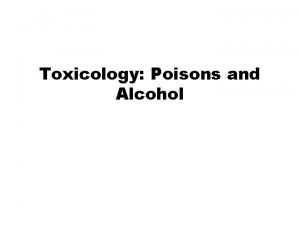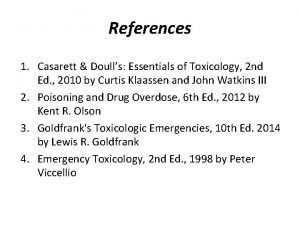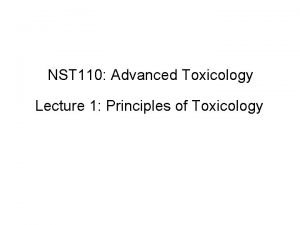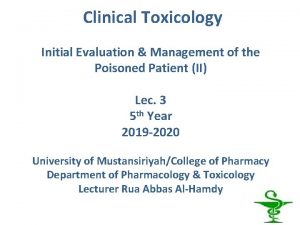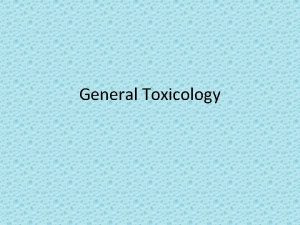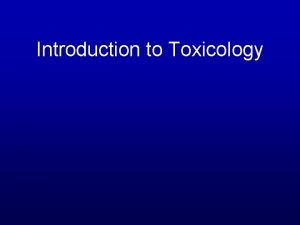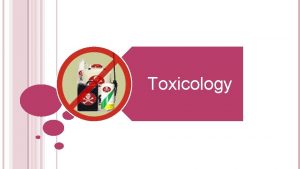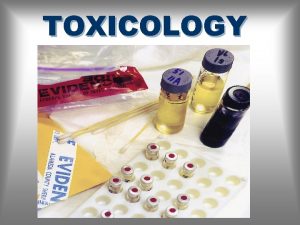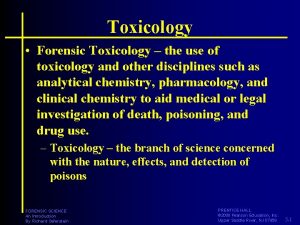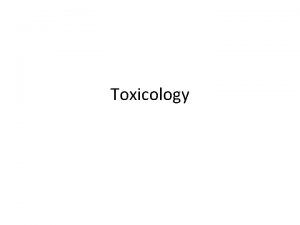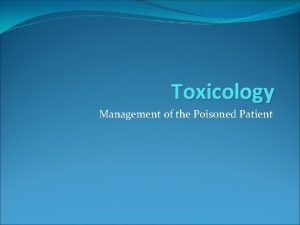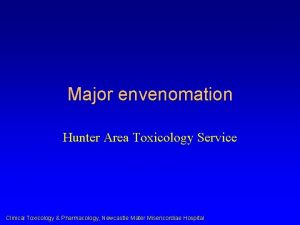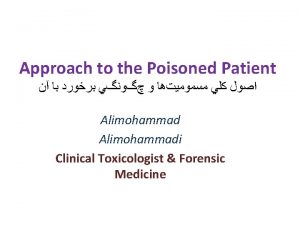Clinical Toxicology Initial Evaluation Management of the Poisoned
































- Slides: 32

Clinical Toxicology Initial Evaluation & Management of the Poisoned Patient (II) Lec. 3 5 th Year 2019 -2020 University of Mustansiriyah/College of Pharmacy Department of Pharmacology & Toxicology Lecturer Rua Abbas Al-Hamdy

Objectives of lecture: Objectives of this lecture are: § to identify the methods used for enhancement of poison elimination, & § to identify the antidotes & therapeutics used in poisoning.

Techniques applied to enhance elimination: q Forced diuresis q Manipulation of urinary p. H q Whole-bowel irrigation q Extracorporeal techniques: § Peritoneal dialysis § Hemoperfusion § Plasmapheresis

Forced diuresis: § Forced diuresis by volume expansion with isotonic sodium–containing solutions, such as 0. 9% Na. Cl & lactated Ringer solution, may increase renal clearance of some molecules. § This therapy would theoretically be most useful for xenobiotics such as lithium for which the glomerular filtration rate (GFR), which is the volume of plasma filtered across the glomerular basement membrane per minute, is an important determinant of excretion.

§ In people with normal extracellular fluid (ECF) volume who have not had loss of sodium via renal, GI, or other routes of excretion, the increase in GFR expected with plasma volume expansion is variable & unpredictable & may not lead to significant increases in xenobiotic elimination. § The effect of diuresis is potentially more important in patients who have had contraction of the extracellular fluid (ECF) volume because of sodium loss.

§ The significant risk of this therapy is ECF volume overload, manifested by pulmonary & cerebral edema. This complication may be particularly likely in patients with long-standing lithium use in whom chronic tubulointerstitial disease may lead to renal insufficiency that does not improve with fluid therapy.

Manipulation of urinary p. H: § Many xenobiotics are weak acids or bases that are ionized in aqueous solution to an extent that depends on the p. Ka of the compound & the p. H of the solution. § Cell membranes are relatively impermeable to ionized, or polar molecules, while nonionized, nonpolar forms may cross more easily.

§ If the urinary p. H is manipulated to favor the formation of the ionized form in the tubular lumen, the xenobiotic is trapped in the tubular fluid & is not passively reabsorbed into the bloodstream. This is referred to as ion trapping.

§ Clinical use of this alkalinization procedure requires adequate urine flow & close clinical monitoring including that of the p. H of the urine. § The procedure is accomplished by adding sterile sodium bicarbonate to sterile water with 5% dextrose for intravenous (IV) infusion and administering the mixture intravenously to titrate the urine p. H to 7. 5 to 8. 5. § The drugs for which this procedure has been shown clinically efficacious include salicylate compounds & phenobarbital.

§ Theoretically, there are similar advantages to be gained from acidification of the urine regarding enhancement of clearance of drugs such as amphetamine & phencyclidine; however, there are significant adverse events associated with acidification such as acute renal failure & acidbase & electrolyte disturbances. For this reason, acidification of the urine is not recommended as a therapeutic intervention in the treatment of poisoning.

Dialysis techniques: § The dialysis techniques, either hemodialysis, or peritoneal dialysis, relies on passage of the toxic chemical through a semipermeable dialysis membrane (or the peritoneal membrane for peritoneal dialysis). § Dialysis is governed by the laws of osmosis. A diffusible chemical dissolved in water partitions across a semipermeable membrane, & the solution moves from an area of higher concentration (i. e. , the blood) to one of lower concentration (i. e. , a dialyzing solution).

Peritoneal dialysis: Peritoneal dialysis is the most easily performed method and is associated with the lowest risk for complications. However, it is also the least effective method for removing most poisons.

Procedure of peritoneal dialysis: § A warmed sterile dialyzing solution (up to 2 L for adults and 1 L for children) is introduced into the peritoneal cavity over a period of 15 to 20 min. § The fluid is left in place for 45 to 60 min for equilibration to occur and then removed. § A fresh solution is reintroduced & the process repeated. Up to 30 L or more of dialysis fluid may be used.

Complications of peritoneal dialysis: These include abdominal pain, intraperitoneal bleeding, intestinal, bladder, liver, or spleen perforation, & peritonitis.

Hemodialysis: § In order for this method to be clinically beneficial, the chemical must have: • a relatively low volume of distribution (Vd) (Vd <1 L/kg), • low protein binding, • a relatively high degree of water solubility, & • low molecular weight (MW) (MW <500 daltons).

§ Vascular access is best attained via the femoral vein. § Hemodialysis & hemoperfusion are usually performed using a double-lumen catheter manufactured for dialysis. Blood is pumped through one lumen, passed through the machine, & returned to the venous circulation through the second lumen.

Diagram illustrating hemodialysis

§ For anticoagulation, heparin is usually required, unless it is contraindicated. § In poisoned patients, hemodialysis is usually performed for 4 to 8 hours.

§ Drugs & chemicals for which hemodialysis has been shown to be clinically effective in the treatment of poisoning by these agents is shown in Table 1. Chemicals for which hemodialysis has been shown effective as a treatment modality for poisoning

§ Complications of acute hemodialysis are relatively rare. These include: • Bleeding or thrombosis at the site used for vascular access, usually the femoral vein, is infrequent with normal hemostasis & adequate postprocedure. • Bleeding in the GI tract & elsewhere, caused by systemic anticoagulation with heparin, can be avoided if low doses of heparin are used. • Nosocomial bacteremia may occur if central lines are left in place for prolonged periods; central lines should be removed after 5 days at most.

Hemoperfusion: § The technique of hemoperfusion is similar to hemodialysis except there is no dialysis membrane or dialysate involved in the procedure. § The patient’s blood is pumped through a perfusion cartridge containing an adsorptive material (usually activated charcoal) that has a coating of material such as cellulose or a heparincontaining gel to prevent the adsorptive material from being carried back to the patient’s circulation.

§ As with hemodialysis, patients must be anticoagulated with heparin. § Hemoperfusion is usually performed for 4 to 6 hours at flow rates of 250 to 400 m. L/min as tolerated. § The principle characteristics for a drug or other chemical to be successfully removed by this technique are • low volume of distribution (Vd) (Vd <1 L/kg) & • adsorption by activated charcoal.

§ This method can be used successfully with lipid soluble compounds & with higher molecular weight compounds than for hemodialysis. § Protein binding does not significantly interfere with removal by hemoperfusion.

§ The medical risks of this procedure include thrombocytopenia, hypocalcemia, & leukopenia. § This technique is primarily used for the treatment of serious theophylline overdose, & possibly amanita toxin exposure, as well as paraquat & meprobamate poisoning. § A practical problem limiting the use of charcoal hemoperfusion is the availability of the cartridges.

§ Chemicals removed by hemoperfusion (more efficiently than hemodialysis) are listed in Table 2. Chemicals removed by hemoperfusion (more efficiently than hemodialysis)

Plasmapheresis & exchange transfusion: § Plasmapheresis & exchange transfusion are intended to eliminate xenobiotics with large molecular weights that are not dialyzable. This includes xenobiotics & endogenous molecules with molecular weights greater than 150, 000 daltons, typified by immunoglobulins. § The xenobiotic to be eliminated should also have limited endogenous metabolism to make pheresis or exchange worthwhile.

§ By removing plasma proteins, both techniques offer the consequent potential benefit of removal of proteinbound molecules such as Amanita toxins, thyroxine, & vincristine. § Pheresis is particularly expensive, & both pheresis & exchange transfusion expose the patient to the risks of infection with plasma- or blood-borne diseases.

§ Replacement of the removed plasma during plasmapheresis can be accomplished with freshfrozen plasma, albumin, or combinations of both. The former is associated with hypersensitivity reactions, such as fever, urticaria, wheezing, & hypotension. § A different setting in which exchange transfusion may be an appropriate technique is in the management of small infants or neonates in whom dialysis or hemoperfusion may be technically difficult or impossible.

§ In premature neonates, a single volume exchange appeared to alleviate manifestations of theophylline toxicity. The therapy has been successfully used to treat other pediatric patients with poisonings, including severe salicylism.

Antidotes & therapeutics for the treatment of poisonings & overdose: Therapeutics Uses Atropine Bradydysrhythmias, cholinesterase inhibitors (organic phosphorus compounds, physostigmine) Benzodiazepines Seizures, agitation, stimulants, ethanol and sedative–hypnotic withdrawal, cocaine, chloroquine, organic phosphorus compounds Dantrolene Malignant hyperthermia Deferoxamine mesylate Iron Dextrose in water (50% adults; 20% pediatrics; 10% neonates) Hypoglycemia Digoxin-specific antibody fragments (Digibind & Digifab) Cardioactive steroids

Therapeutics Dimercaprol Lewisite) (BAL, British Uses anti- Arsenic, mercury, gold, lead Flumazenil Benzodiazepines Glucagon β-Adrenergic antagonists, channel blockers N-acetylcysteine Acetaminophen Naloxone hydrochloride Opioids, clonidine D -Penicillamine Copper Pralidoxime chloride, Acetylcholinesterase inhibitors (organic phosphorus agents & carbamates) Protamine sulfate Heparin anticoagulation Succimer Lead, mercury, arsenic Vitamin K 1 Warfarin or anticoagulants calcium rodenticide

 The curse of the poisoned pretzel
The curse of the poisoned pretzel Lajin stretch premature
Lajin stretch premature Toxicology management
Toxicology management Clinical evaluation of language fundamentals 5
Clinical evaluation of language fundamentals 5 Toxicology is the study of
Toxicology is the study of Tera toxicology
Tera toxicology Father of forensic toxicology
Father of forensic toxicology Definition of forensic toxicology
Definition of forensic toxicology A breath test reflects the alcohol concentration in the
A breath test reflects the alcohol concentration in the Forensics toxicology definition
Forensics toxicology definition Definition of environmental toxicology
Definition of environmental toxicology Chapter 8 toxicology poisons and alcohol
Chapter 8 toxicology poisons and alcohol Chapter 8 toxicology poisons and alcohol
Chapter 8 toxicology poisons and alcohol Washington state toxicology lab
Washington state toxicology lab Forensic toxicology lab activity
Forensic toxicology lab activity Toxicology definition
Toxicology definition Toxicology and applied pharmacology
Toxicology and applied pharmacology North carolina medical examiner toxicology
North carolina medical examiner toxicology Toxicology
Toxicology Examples of toxicology
Examples of toxicology Toxicology
Toxicology Toxicology
Toxicology Toxicology defination
Toxicology defination Which is more toxic
Which is more toxic Annual review of pharmacology and toxicology
Annual review of pharmacology and toxicology Acute toxicity
Acute toxicity Toxicology effects
Toxicology effects Toxicology effects
Toxicology effects Ld50 examples
Ld50 examples Hormesis toxicology
Hormesis toxicology Food safety and toxicology
Food safety and toxicology Forensic toxicology vocabulary
Forensic toxicology vocabulary Drug identification and toxicology
Drug identification and toxicology



